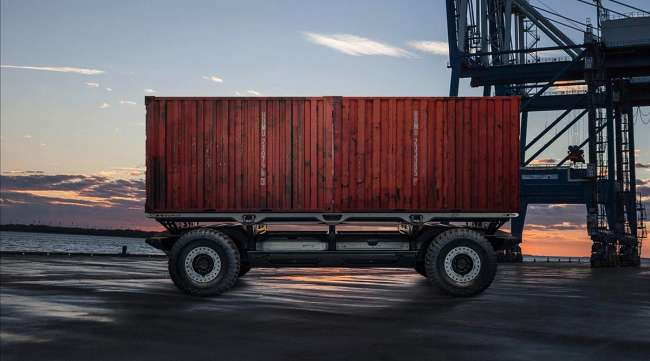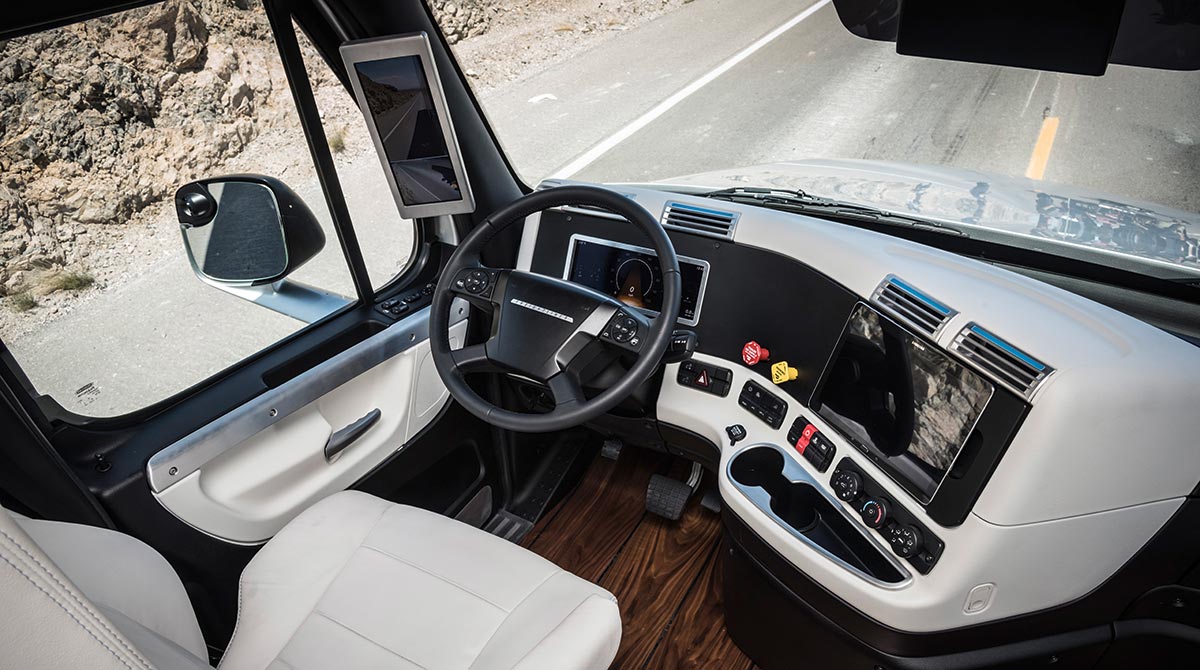Could Driverless Tech Mean Thousands of Trucking Jobs Lost? Probably Not

Truck driving — one of the most in-demand and stable jobs in Ohio — could face major changes as the industry develops new automated, driverless technology.
The technology is coming, according to researchers and trucking industry experts. But they also debate whether or not drivers could lose jobs or how their role behind the wheel might change.
Ohio has about 68,500 truck drivers, according to the U.S. Bureau of Labor Statistics.
Much of the attention nationally has focused on automated cars and light trucks, Todd Davidson, a research associate at the University of Texas at Austin’s Energy Institute, said. But because of the potential economic benefits, he said it’s more likely the trucking industry will take the biggest steps forward in autonomous technology early on.
RELATED: GM shows off autonomous cargo hauling concept vehicle
The industry plays a critical role in moving products across the country to retailers, manufacturing firms and a variety of other industries, Davidson said. Companies throughout the U.S. stand to reap substantial savings if the trucks can be made more efficient or safer.
“It’s absolutely the beachhead to autonomous vehicles,” Davidson said of the industry.
In November last year in Ohio, an autonomous Uber-owned Volvo semi-truck hauled an Ohio Department of Transportation brine tanker along Interstates 70 and 270 and U.S 33 from Columbus to Bellefontaine. A driver took over in construction zones but for most of the trek, technology like GPS and camera sensors kept the truck on the right path.
Ohio is also investing $15 million in a Smart Mobility Corridor, a stretch of U.S. 33 between Dublin and East Liberty being lined with fiber optic cable that can collect data on autonomous and connected vehicles. The Ohio Turnpike between Youngstown and Toledo is also expected to become a testing ground for similar research, and the latest state budget includes funding for additional smart highway projects on I-270 in Columbus and I-90 in northeast Ohio.
RELATED: Autonomy could transform trucking’s future, former GM exec says
The technology that’s making autonomous vehicles possible isn’t new, said Tom Goldsby, chairman of the department of marketing and logistics at Fisher College of Business at Ohio State University. Instead, it’s been a process of steady technological improvements over a span of decades. Benefits include improved efficiency, cost savings for businesses and safety, he said.
But the technology also has hurdles that have slowed implementation, including fears that it could result the disappearance of thousands of truck driving jobs.
“The notion of threatening jobs with automation might be a little hard to digest politically,” Goldsby said.
Allen Schramm is a truck driver for Woodruff Enterprises in Springfield. Technology that was once hard to imagine, like global positioning systems, are now taken for granted, he said.
But after a roughly 30-year career, he doesn’t believe drivers will be out of the equation any time soon. Schramm said he’s skeptical automated trucks can perform some critical tasks, including navigating harsh weather conditions or maneuvering in crowded cities.
“They’ll always be in demand,” he said of truck drivers.
A national debate
Troy Clarke, Navistar’s CEO, provided some clue of what trucking’s future might look like earlier this year during testimony before the Senate Commerce, Science and Transportation Committee, where he urged lawmakers to include the industry in legislation to develop rules for autonomous vehicles.
Clarke testified on behalf of the industry after federal lawmakers proposed legislation designed to bar states from preventing self-driving vehicles and to develop federal standards to get autonomous vehicles to market more quickly. The legislation focused on passenger vehicles and didn’t include commercial trucks.
Leaving trucks out of the legislation could lead to potential safety hazards in the future, Clarke testified, if both industries aren’t on the same page. The industry will still need drivers as technology improves, he said, but those jobs will entail different duties.
RELATED: Uber plans self-driving, longhaul trucks on the road ‘in the near future’
“Drivers will become more like airline pilots — even more highly trained and skilled than they are today … For example, an autonomous vehicle may be deployed on a straight highway with mixed vehicles, while the driver in his or her seat is managing the controls and monitoring several platooning trucks, and ensuring the safe and secure operation of the trucks under their care,” Clark told senators.
The impact on jobs is hard to predict, but Davidson, of University of Texas, said the idea of platooning is a likely next step. In those cases, several trailers follow closely behind a lead truck, drafting to save fuel and improve cost and efficiency.
“Platooning is a wise way to look at it, where the productivity of an individual driver would actually go up significantly because they might be commanding seven trucks rather than just a single one,” Davidson said. “It almost seems to be from a jobs perspective, you would have potentially fewer drivers but more highly paid and skilled labor.”
Trucking companies are keeping an eye on driverless technology, said Kevin Burch, president and partner of Jet Express in Dayton and immediate past chairman of the American Trucking Associations. But it’s unlikely the 3.5 million truck drivers currently licensed in the U.S. will be out of work any time soon, he said.
“Do we have the technology? We do,” Burch said. “In reality it’s probably 15 to 20 years out.”
RELATED: Alphabet launches the first taxi service with no human drivers
Some organizations have urged federal lawmakers to move ahead with caution, noting increased automation would affect the nature of work for not only drivers, but for nearly every part of the transportation industry.
“I have yet to hear a serious discussion about how we will make sure an 80,000-pound automated truck will be able to maneuver around a warehouse or drop yard and not injure countless workers also occupying that same space,” testified Ken Hall, general secretary treasurer for the International Brotherhood of Teamsters. “Or how we would make sure that the rules governing a driver’s training requirements would be updated the moment one of these new vehicles is put on the road. And we haven’t gotten to the largest issue of them all, the potential impact on the livelihoods and wages of millions of your constituents.”
RELATED: Unions urge slowdown as self-driving car laws pick up speed
The Owner-Operator Independent Driver’s Association, which represents drivers not affiliated with larger companies, isn’t opposed to autonomous technology, spokeswoman Norita Taylor said. But she argued commercial trucks should be considered separately from passenger vehicles, and safety and jobs should be a priority for lawmakers.
“There are also ethical considerations that have to be taken into account,” Taylor said. “Are we really ready to turn over those decisions to computers? If everyone believes that autonomous means ‘flawless,’ we are mistaken. Think about how often you have been in front of your computer and it’s locked up or crashed. There are also cyber-security issues to consider when you have 80,000 vehicles that could possibly be controlled by those with bad intentions.”

A Freightliner autonomous truck on the road in Nevada, Photo by Daimler AG.
Navistar impact
The move to self-driving trucks won’t happen all at once, said Darren Gosbee, vice president of advanced powertrain for Navistar. Instead background technologies that make trucks safer will increasingly be implemented over the next several years.
Improvements like cruise control or traction control that many drivers now take for granted were the building blocks for autonomous vehicles, Gosbee said. Progress toward fully autonomous vehicles will be incremental as new features improve or become available, he said.
“It is a combination of advanced driver assistance systems that really build upon one another to take us to this point of autonomy,” Gosbee said.
Most of the early uses will occur on freeways, he said, where traffic moves in one direction and lanes are clearly marked. But the technology will move slowly, over a span of several years. Technologies that might be in use in the next few years could allow vehicles to automatically accelerate or slow down, depending on the flow of traffic, without driver input.
Instead of lane departure warnings, Gosbee said the industry is closer to lane management systems in which an electric motor on the steering column can take over and bring the vehicle back to the center of the lane.
“I certainly don’t foresee a big bang event,” Gosbee said. “I don’t see where today we have normal trucks and tomorrow we have a cabless vehicle. It will be over many years.”
Barriers will slow the implementation of the technology as well, he said. Currently no national framework allows autonomous vehicles to be developed on highways. Instead, transportation is regulated by states, Gosbee said, leading to a patchwork of rules.
Utilizing autonomous features on a highway is relatively straightforward, he said, but the technology still needs to improve to handle the countless scenarios in more complicated urban environments.
Some individuals might enjoy the idea of autonomous vehicles. For others, the idea of a driverless commercial truck rolling down the highway is disconcerting, Gosbee said, even if the technology is safe.
“The moment you start seeing 18-wheelers driving down the road with no one behind the wheel, that’s probably going to be an eye-opener to a large number of people,” Gosbee said.
Human element
Gosbee and other experts predict a human element will still be involved, although the role of drivers will likely change.
Drivers likely will act more as a pilot coordinating with autopilot features on a passenger jet, Burch said. The driver may take control at times and ensure the safety of the cargo, while allowing the autonomous technology to take over in other instances.
“I’m the owner of a small fleet and I sure wouldn’t want to come up on a truck with nobody in it,” Burch said.
The commercial trucking industry will need as many as 900,000 drivers over the next decade as the current workforce ages, Burch said. But he predicted autonomous technology won’t be a solution to that problem.
“To totally not have a driver in the truck is not going to be a reason why we cure the driver shortage,” Burch said. “We’re still going to need somebody in there to assist in maneuvers. They’re still going to have to watch the gauges, they’re going to have to watch weather conditions.”
One major accident on the roadway could set back autonomous vehicles for years, Burch said. That’s another reason to push the technology forward in increments, he said, and give commercial trucking a seat at the table when developing the rules.
“There are a lot of good things that could come out of this,” Burch said. “The last thing we want to do is risk a life after all that we’ve done to hurry up technology.”
Hall, of the International Brotherhood of Teamsters, testified he wasn’t opposed to the technology. But he argued workers should have a say in how it’s implemented.
“My career has shown me that new technologies can exist in an environment where workers are still taken care of,” Hall said. “But it takes strong and aggressive action from those workers to make sure that happens.”
Distributed by Tribune Content Agency, LLC




